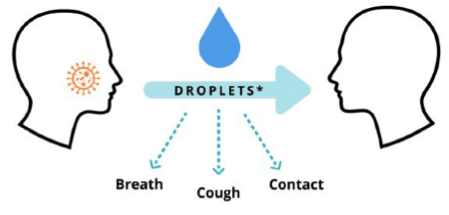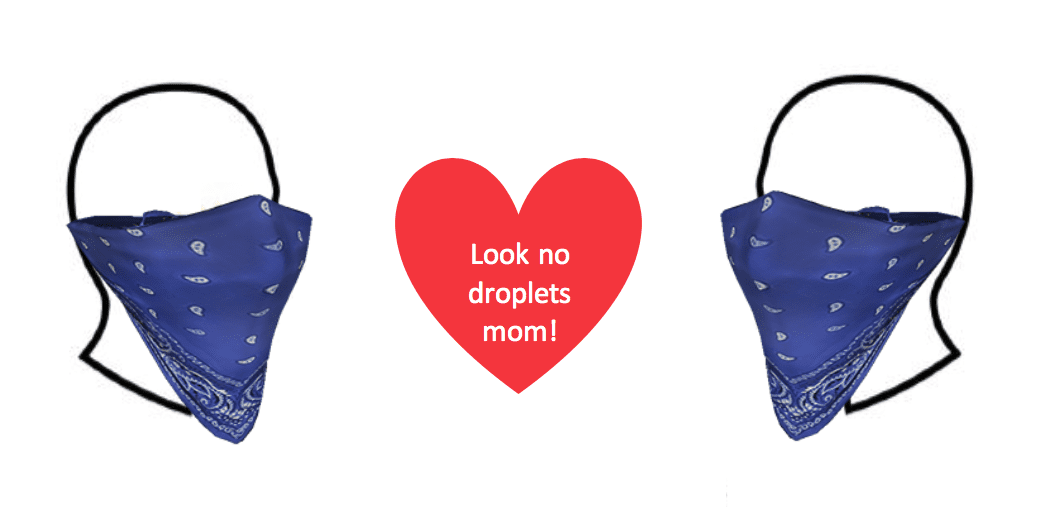How to make a DIY (Do It Yourself) Mask
You might not know you’re infected so cover your nose and mouth when you’re in public. Your mask protects others from the virus even more than it protects you. But if we all do it, we can stop the spread for all of us.
"I PROTECT YOU. YOU PROTECT ME!"

Leave the surgical masks for health care workers and take the #DIYMaskChallenge now. Let’s get started!
- Pick your material (tightly woven cotton is recommended by most people– try a t-shirt, towel or bandana). See links below for more info on materials. You can double your layers too.
- Wash it with hot soapy water so it’s clean and pre-shrunk.
- Wash your hands with soap for 20 sec.
- Assemble your mask.
You can search online for DIY Masks. Below are some links we found helpful.
If you receive masks from others, do what the hospitals do, ASSUME THEY COME TO YOU CONTAMINATED and wash them in hot soapy water - do the same for your hands.
If you are near someone without a mask, protect yourself by stepping away from them and ask them to wear a mask too.
Wear Mask + Social Distancing + Hand Washing = Stop Spread
We recommend making yourself three masks so you always have a clean one ready to use. You’ve got an old T-shirt – that’s your first backup mask.
Lots of videos say to wear a mask for your protection – but any mask that can filter virus particles coming in can do an even better job of stopping droplets going out that are even bigger. Even a T-shirt used as a mask is helpful to protect others.
Stop the droplets. Stop the spread. Your mask protects them – Their mask protects you!

HOW TO MAKE A DIY FACEMASK
New York Times
It’s Time to Make Your Own Face Mask
Here’s how to do it.
March 31, 2020
https://www.nytimes.com/2020/03/31/opinion/coronavirus-n95-mask.html
“Contrary to what American officials told us, many studies show that widespread mask-wearing might be a very effective complement to hand-washing, social-distancing and other measures to mitigate the pandemic. Health officials in China, Hong Kong, Singapore and Japan suggest that people wear masks in certain situations — if they’re symptomatic, for instance, or if they’re in crowded, not-very-well-ventilated places, like airplanes. Studies have also shown that mask-wearing (in conjunction with hand-washing) reduces the spread of infection within households or other shared living spaces, like residence halls.
But how to get your hands on a mask, when there are no masks? The internet has a plan: Make your own.”
IN A HURRY - USE A T-SHIRT OR DISH TOWEL
The main purpose of your mask is to PROTECT OTHERS around you. Doubled up t-shirts or dish towels can catch the droplets coming from your mouth.
While masks can also protect you a little from those around you, the best way to stay safe is to maintain 6' social distancing and insist that others use a mask too.
To use a dishtowel, you can pull two corners, wrap it around your face and tie it behind your head.
To use a t-shirt, you can fold it in half twice from the top to the bottom leaving the two arms sticking out to the sides and secure them to each other in the back of your head using heavy tape, a binder clip or a clothespin.
For either one, you need to cover the sides of your mouth and down to your chin to prevent droplets from escaping or getting in.
MASKS THAT DON’T REQUIRE SEWING
Best Way To Wear Handkerchief Mask: (https://www.youtube.com/watch?v=LanRCaF3KX8)
SEWING REQUIRED
These are aimed at masks for donation to hospitals but can also be used to make a mask for yourself and family members. Although these mostly use sewing machines, there is no reason you can’t sew them by hand. It just takes longer.
From Deaconess Hospital
How to make a Face Mask video
(https://www.youtube.com/watch?v=9tBg0Os5FWQ)
Written instructions and patterns
(https://www.deaconess.com/How-to-make-a-Face-Mask)
Fabric Patch - Three videos and information on materials (http://www.fabricpatch.net/face-masks-for-covid-19-relief.htm)
A surgeon shows how to make a surgical mask
(https://www.drstreicher.com/dr-streicher-blog/2020/3/a-surgeon-sewing-a-surgical-mask)
DIY Cloth Face Mask (https://www.instructables.com/id/DIY-Cloth-Face-Mask/)
(Aimed at self-protection, but if a mask will protect you, it will protect others too)
DIY Face Mask with a pocket for a filter
(https://www.youtube.com/watch?v=vTJevg9i7XA)
FOR THE DIY ENGINEERS
What are the Best Materials for Making DIY Masks?
(https://smartairfilters.com/en/blog/best-materials-make-diy-face-mask-virus/)
A Doctor Explains How to Make a Mask with a HEPA vacuum filter
(https://www.youtube.com/watch?v=W6d3twpHwis)
How to make a (nearly) N95 medical face mask
(https://www.youtube.com/watch?v=oLSa8pFStVE)
How to wear your mask
• Before putting on a mask, clean hands with alcohol-based hand rub or soap and water.
• Cover mouth and nose with mask and make sure there are no gaps between your face and the mask.
• Avoid touching the mask while using it; if you do, clean your hands with alcohol-based hand rub or soap and water.
• To remove the mask: remove it from behind (do not touch the front of mask); wash with hot soapy water; clean hands with alcohol-based hand rub or soap and water
(*Adapted from World Health Organization: When and how to wear medical masks to protect against coronavirus)
Disclaimer: None of the authors, contributors, administrators, or anyone else connected with this website, in any way whatsoever, can be responsible for your use of the information contained in or linked from these web pages. Any action you take upon the information on this website and others is strictly at your own risk and we will not be liable for any losses or damages in connection with the use of our website.